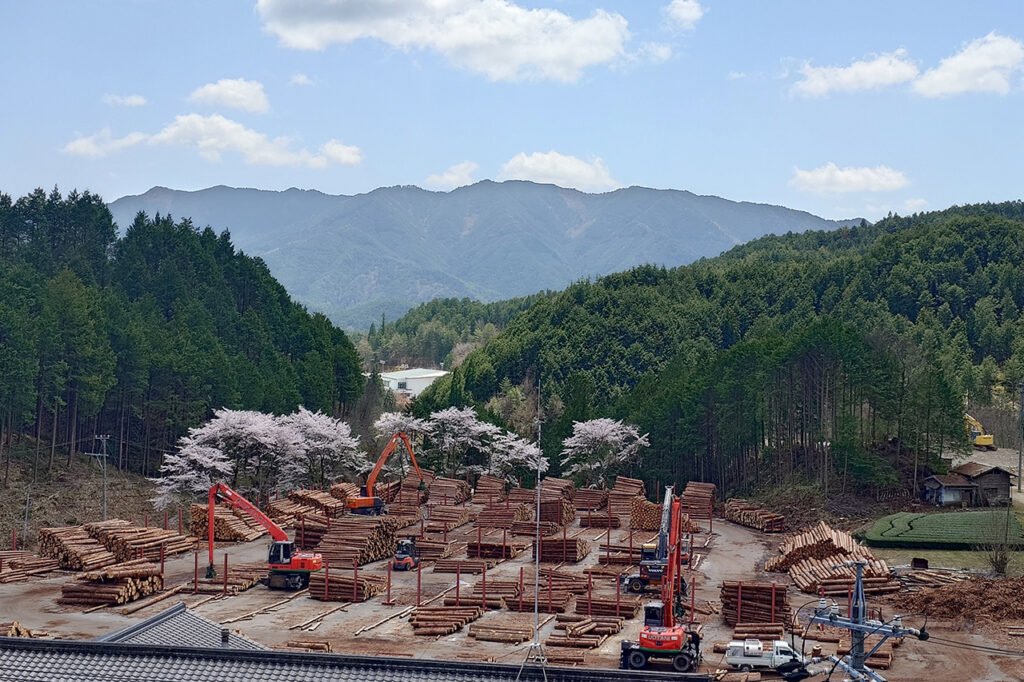Updated by "Forest Circular Economy" Editorial Board on May 01, 2025, 1:43 PM JST
Editorial Board, Forest Circular Economy
Forestcircularity-editor
We aim to realize "Vision 2050: Japan Shines, Forest Circular Economy" promoted by the Platinum Forest Industry Initiative. We will disseminate ideas and initiatives to promote biomass chemistry, realize woody and lumbery communities, and encourage innovation in the forestry industry in order to fully utilize forest resources to decarbonize the economy, strengthen economic security, and create local communities.
A new initiative to promote green transformation (GX) of the timber industry has begun in the Shirakawa River basin in Gifu Prefecture, which produces famous timbers such as Tono hinoki and cedar. The Tono Hinoki Products Distribution Cooperative Association, in cooperation with members of the Shirakawa Local Supply Chain (LSC), has launched a project to visualize CO2 emissions in the manufacturing process of wood products, utilizing a SaaS-type CO2 visualization service, aiming to realize "lumber that can be selected based on its environmental performance.
The Shirakawa River basin (Shirakawa Town, Higashishirakawa Village, Kashimo, Nakatsugawa City, etc.) is located in the eastern part of Gifu Prefecture and has a high percentage of forests. Tono Hinoki, grown in the Tono region, is a famous wood shipped nationwide as a structural material for shrines, temples, and high-grade housing because of its fine grain and high durability.
The Shirakawa River basin has formed a "local production for local consumption" timber supply zone where logging, sawing, processing, and shipping can be completed within the region. The entire region has been working on "performance labeling," which clearly states the physical characteristics of lumber, such as moisture content and bending strength. Now they have taken on the challenge of "environmental performance labeling," which specifies the amount of CO2 emissions and fixation, and have stepped into the next stage of communicating the environmental value of lumber.

In the past, accurate monitoring of CO2 emissions required a lot of cost and expertise, making it difficult for small and medium-sized forestry and timber-related businesses to implement. In recent years, however, cheaper and simpler services have emerged, creating an environment in which it has become easier to visualize emissions.
Shirakawa LSC utilizes e-dash, a support platform for visualization and reduction of CO2 emissions. By simply uploading energy-related invoices such as electricity and gas, the amount of direct and indirect CO2 emissions can now be calculated automatically. A system is also in place to easily calculate and visualize emissions for the entire supply chain, utilizing data by industry sector. Through this system, multiple lumber, processing, and distribution companies in the Shirakawa River basin are working together to build a system to share and accumulate emission data for the entire region.
While wood consumes energy and emits CO2 during its production and processing processes, it also has the aspect of a renewable resource that absorbs and fixes CO2 during its growth. In recent years, with the growing awareness of carbon neutrality, it has become increasingly important to accurately understand and reduce the environmental impact of products throughout their life cycles.
Efforts to quantify the environmental advantages of wood are still limited. In particular, clarification of emissions during the manufacturing process is essential to highlight environmental value. Visualizing the environmental performance of each product and displaying it numerically is becoming an increasingly important factor in the selection of building materials and public procurement. The Shirakawa LSC initiative aims not only to deliver sustainable timber, but also to increase the competitiveness of local timber by establishing a system that can clearly show evidence of environmental considerations.

In this region, it is possible to carry out the entire process of logging, sawing, drying, and processing, forming a supply chain-complete timber supply zone where "people and mountains are close. The geographical integration of forestry, manufacturing, and distribution is the very reason for the visualization of CO2 emissions in the region.
What is noteworthy about this initiative is that it seeks to comprehensively understand CO2 emissions throughout the entire supply chain. This is expected to clarify which processes emit which amount of CO2 and lead to the setting of specific reduction targets, the implementation of measures, and the supply of wood products with less environmental impact.
Visualization of environmental performance is more than just a CO2 number. Reliable environmental data adds value to local timber and ensures transparency in distribution. This will also lead to sound forest management and sustainable development of the local economy. It is highly significant for small and medium-sized businesses in forestry areas to take the initiative in using technology to visualize CO2 emissions.